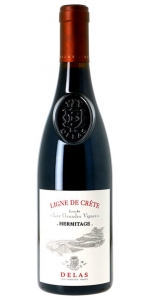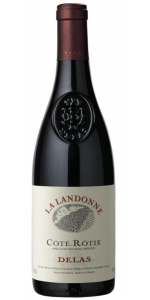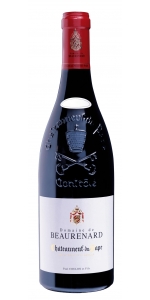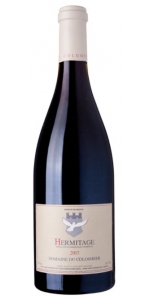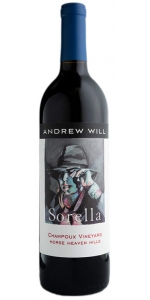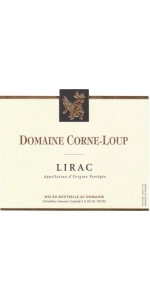Delas Hermitage Domaine des Tourettes 2019
3 bottles with free shipping for: $297.00
6 bottles with free shipping for: $570.00
12 bottles with free shipping for: $1,080.00
| BUY MORE! SAVE MORE! | ||||||||||||||||||||
|
| Country: | France |
| Regions: | Rhone Hermitage |
| Winery: | Delas Freres |
| Grape Type: | Syrah |
| Vintage: | 2019 |
| Bottle Size: | 750 ml |
Delas Hermitage Domaine des Tourettes is made from Syrah.
The wine has a brilliant, deep red hue. The nose is powerful and complex, expressing blackberries, spices and leather. On the palate the wine is firm but silky, with a tightly-knit tannic structure that is the hallmark of wines that have a good future.
Pair this wine with rare or medium-cooked games, marinated meats and spicy stews. We recommend opening this bottle between one and three hours before drinking
Review:
A blend of fruit from the lieux-dits Les Bessards, Le Sabot and L’Ermite, this 2019 draws together a picture of the Hermitage hill in all its grandeur and complexity. At its center, it’s bright and juicy, filled with ripe berry flavors; around the edges, it’s stony and firm, with herbal notes that accent its cool reserve. It shows some vanilla and spice tones from its time in oak (a mix of new and barrels) but the fruit handles it well, absorbing it into a warm, rich density of flavor. This should age well for 20 years or more.
-Wine & Spirits 96 Points
The celebrated Delas Frères wine company was founded back in 1835. Since 1996, the spirit and soul that contributed to its reputation for high quality wines have been restored. The company's new management has made important investments in the Saint-Jean-de-Muzols production site near Tournon-sur-Rhône.
Its highly-motivated team is proud to play its part in the revival of the quality of this venerable Rhône Valley wine company. A specially designed vat-house for the vinification of red wines, as well as a full restructuring of the ageing cellars, are among the new quality measures at Delas, all aimed at perpetuating and enhancing the expression of the terroir.
Delas wines are crafted by a winemaking team composed of Jacques Grange and Claire Darnaud, whose wines have been heralded for their intensity of flavor and excellent value.
Jacques Grange
Jacques Grange joined Delas Freres as winemaker in June 1997. Grange holds a degree in oenology from the University of Dijon and has extensive winemaking experience, including a four-year stint at Chapoutier working directly with Michel Chapoutier from 1991 to 1994. Grange has worked with Jean-Luc Colombo, one of the Rhône’s most respected oenology consultants. In this position, he worked closely with nearly all of the Rhône’s wine estates, including Vernay, Domaine de La Janasse, Cuilleron and Château Fortia. In addition to a deep knowledge of the region’s diverse vineyards and microclimates, Grange has developed strong connections with the people of the Rhône Valley through his work.
Claire Darnaud
Though Claire’s father originally is from the Saint-Joseph area in the Ardèche area, Claire was born and raised in Germany. She studied in France and had a work experience at Delas Freres in 1996. This experience determined her path into the winemaking profession. For five years she worked for a different producer in the Northern Rhône appellation, while immersing herself as much as possible into the local wine community. In 2000, she traveled to Tasmania to work a vintage at Pipers Brook Vineyard, and ended up working in Australia for 5 years. She spent 2 of them in Tasmania and 3 years in the Great Southern part of WA, focusing on cool climate. During this period, she also traveled to France to work the 2002, 2008, and 2009 vintages at Delas. In 2010, she returned to France and became a full time winemaker at Delas Freres. As you can see from her journey, the “Leitmotif” in all of this has been Delas. What makes it so special to her? "First, the amazing vineyards, especially on the Hermitage, which can leave no one indifferent, but also the incredible fruit resources from a number of local growers that Delas has worked with for years. There is the constant will to improve quality, whether it is in the vineyards or in the winery — and the determination and freedom to do so."
Delas has vineyard holdings on the steep granite slopes of the northern Rhône and purchases additional wine through long-term contracts with high quality southern Rhône growers. Crafted by winemaker Jacques Grange to epitomize finesse and elegance, Delas’ northern and southern Rhône vintages have won praise for their intensity of flavor and excellent value.
Delas now owns 77 acres of prime vineyards in the northern Rhône, including 24 acres on the famed Hermitage hill.
Delas Hermitage Les Grandes Vignes Ligne de Crete is made from Syrah.
The nose discloses aromas of spice and leather intertwined with deep berry aromas (blackberry, redcurrant) and heady floral notes, liquorice and incense. Its richness, complexity and elegance are by no means a contradiction. The finest granite soils of the Hermitage hillside are to thank for this wine's incredible minerality and finesse. The wine is rich and dense on entry to the palate, where it shows an elegant, broad and flavorsome character. The ripe, smooth and well-integrated tannins contribute to the wine's powerful yet harmonious structure. The palate reveals the same aromas as those found on the nose with nuances of blueberry, raspberry, violet and bitter chocolate. Ligne de Crête is characterized by its exceptional structure, harmony and balance.
This remarkably smooth and elegant wine makes the perfect partner for a pigeon pie, beef tartare ravioli or a roast fillet of deviled duckling with cranberries. It also makes an excellent choice for woodcock, hare "à la Royale" or even a roast rack of lamb in a herb crust.
Review:
Whiffs of espresso, ore and charred meat mingle into thunderous flavors of crème de cassis and roasted plums in this wine. A single-site expression of Les Grandes Vignes from a ripe yet fresh vintage, it's a showstopping Syrah marked with a creamy texture and ripe tannins. Hermitage is not known for youthful pleasures but this rare bottling embraces the hedonism of adolescence along with its potential to gain power and complexity far beyond 2050. Anna Lee C. Iijima
-Wine Enthusiast 97 Points
Inky ruby color. Expansive, smoke- and mineral-accented black and blue fruits, licorice, smoky bacon, mocha, violet and licorice on the highly perfumed nose. Appealingly sweet, mineral-accented cassis, boysenberry, fruitcake, floral pastille and vanilla flavors show superb depth and become spicier with aeration. Shows superb detail and mineral lift on the youthfully tannic, extremely persistent and incisive finish, which features resonating floral and exotic spice notes.
-Vinous 97 Points
Delas Freres Cote Rotie La Landonne Rouge is made from 100 percent Syrah.
This very ancient region dates back to the Roman Era and is located on the right bank of the Rhône. It is said that during the Middle Ages, “The Seigneur de Maugiron” gave a hillside to each of his two daughters - one was brunette and the other fair - thus, were born the names of “Côte Brune” and “Côte Blonde.” Wines from the Côte Blonde tend to be more delicate and lighter in character than the fuller wines of the Côte Brune. Together, they make a wine of style and substance. This cuvée is a vineyard plot selection. The grapes come exclusively from a plot within the named slope of “La Landonne.”
This cuvée‘s first vintage was 1997. The wine is only made in the very best years. Its highly limited production never exceeds 2,500 bottles per year.
The steep, terraced hillsides along the river produce wines that are among the "biggest" reds of France. The Delas Côte-Rôtie is primarily Syrah with an addition of up to 10 to 20% of Viognier grapes in the crop. The soils of the northern part of the Côte Brune vineyard consists of extremely steep, terraced slopes of ferruginous mica schists which are covered with schist sand (arzel). The Côte Blonde has a varied geology with gneiss and granite predominating at the most southern side of the appellation. The area has dry, hot summers with regular rainfalls during other seasons. The grapes for the “La Landonne” cuvée are picked by hand at maximum maturity. Fermentation takes place in traditional open-topped concrete tanks, following three days of pre-fermentation cold maceration. Before fermentation, the maceration process continues under controlled temperatures of 82°F to 86°F. Daily cap pushing down and pumping over are carried out for about 10 days with total vatting time of up to 20 days. The wine is aged for 14 to 16 months in new or one year old oak casks. The barrels are topped up regularly.
Food Pairing: This wine pairs wonderfully with fine meats, roasted beef, water games, truffles and spicy stews. The bottle should be opened 1 to 3 hours before drinking. This wine needs at least 3 years cellaring before it can open up its complexity. In such case it is strongly recommended to decant before serving.
Tasting Notes: The wine‘s deep color is underscored by plummy hues. A complex nose shows deep, fruity aromas with hints of licorice and roasted coffee. Endowed with a dense and silky tannic structure, this is a full, fleshy wine that provides an ample and generous palate. Its lasting finish speaks of considerable ageing potential.
Reviews:
This is dark and still a bit reticent, with a cast iron cloak around the core of dark currant, plum and blackberry paste flavors, showing lots of sweet bay leaf, anise and singed apple wood notes in the background. There's serious grip through the finish. For the cellar.
-Wine Spectator 96 Points
Very open, spicy and fresh on the nose, you could almost open this now. Struck flint notes assist in teasing out notes of leaf tea, tobacco, rosemary and rose. Very full-bodied, generous but powerful on the palate, tense and mineral. Mouthcoating ripe, sweet tannin and robust amounts of sweet baking spices, along with more tobacco and black fruit on the palate. Has depth, length, power and impressive balance despite the high alcohol. Drink from now into 2022, or from 2031 to 2040. Lieu-dit La Landonne, from the Brune side (mica schist bedrock). Matured in new and one-year-old barrels for 14 months.
-Decanter 96 Points
The 2019 Côte Rôtie La Landonne comes from one of the greatest sites for Syrah in the world, the La Landonne lieu-dit located close to the center of the appellation, on the Côte Brune side. It reveals a deeper purple hue (it's slightly more opaque than the Seigneur de Maugiron) and offers a brilliant nose of ripe cassis, black raspberries, scorched earth, smoked herbs, and seared meat. Full-bodied and powerful on the palate, this is a deep, spicy, concentrated Côte Rôtie with a plush, layered mouthfeel, sweet tannins, beautiful balance, and a great, great finish. This puppy brings the fruit, opulence, and texture of the vintage yet still has a classic Côte Rôtie character.
-Jeb Dunnuck 96 Points
Fresh aromatic layers of mint sit atop crushed red cherries and wild strawberries, with light clove and thyme on the nose. The palate is rich and enticing with black cherries, plums, rhubarb, pomegranate seeds, black olives and freshly picked rosemary leaves. Tremendous texture, structure, and refreshing acidity carry this wine to a robust finish of orange zest and black tea leaves. Maisons Marques & Domaines USA.
- Wine Enthusiast 96 Points
Overview
This very ancient region dates back to the Roman Era and is located on the right bank of the Rhône. It is said that during the Middle Ages, “The Seigneur de Maugiron” gave a hillside to each of his two daughters - one was brunette and the other fair - thus, were born the names of “Côte Brune” and “Côte Blonde.” Wines from the Côte Blonde tend to be more delicate and lighter in character than the fuller wines of the Côte Brune. Together, they make a wine of style and substance. This cuvée is a vineyard plot selection. The grapes come exclusively from a plot within the named slope of “La Landonne.”
This cuvée‘s first vintage was 1997. The wine is only made in the very best years. Its highly limited production never exceeds 2,500 bottles per year.
Winemaking
The steep, terraced hillsides along the river produce wines that are among the "biggest" reds of France. The Delas Côte-Rôtie is primarily Syrah with an addition of up to 10 to 20% of Viognier grapes in the crop. The soils of the northern part of the Côte Brune vineyard consists of extremely steep, terraced slopes of ferruginous mica schists which are covered with schist sand (arzel). The Côte Blonde has a varied geology with gneiss and granite predominating at the most southern side of the appellation. The area has dry, hot summers with regular rainfalls during other seasons. The grapes for the “La Landonne” cuvée are picked by hand at maximum maturity. Fermentation takes place in traditional open-topped concrete tanks, following three days of pre-fermentation cold maceration. Before fermentation, the maceration process continues under controlled temperatures of 82°F to 86°F. Daily cap pushing down and pumping over are carried out for about 10 days with total vatting time of up to 20 days. The wine is aged for 14 to 16 months in new or one year old oak casks. The barrels are topped up regularly.
Tasting Notes
The wine‘s deep color is underscored by plummy hues. A complex nose shows deep, fruity aromas with hints of licorice and roasted coffee. Endowed with a dense and silky tannic structure, this is a full, fleshy wine that provides an ample and generous palate. Its lasting finish speaks of considerable ageing potential.
Food Pairing
This wine pairs wonderfully with fine meats, roasted beef, water games, truffles and spicy stews. The bottle should be opened 1 to 3 hours before drinking. This wine needs at least 3 years cellaring before it can open up its complexity. In such case it is strongly recommended to decant before serving.
Domaine de Beaurenard Chateauneuf-du-Pape is made from 65% Grenache, 15% Syrah, 10% Mourvèdre.
Domaine de Beaurenard’s flagship wine is a quintessential blend, reflecting all the diversity of the terroir and the perfect synergy that exists between the soils and the grapes. It offers a supple and refined texture associated with a delicate aromatic palette that is the result of a constant quest for freshness.
Review:
Checking in as a blend of 65% Grenache, 15% Syrah, 10% Mourvèdre, and the rest a handful of varieties, the 2019 Châteauneuf Du Pape was brought up in a mix of foudre and older barrels. This deep ruby/purple-hued effort has a pure, vibrant, incredibly seamless, medium to full-bodied style that carries classic notes of black raspberry and black cherry fruits as well as peppery herbs, violets, spring flowers, and sous bois. This straight-up gorgeous, seamless, ultra-fine 2019 should be snatched up by readers. It has a rare mix of elegance, purity, and power, and it’s going to have two decades of prime drinking.
-Jeb Dunnuck 95 Points
Domaine du Colombier Hermitage Rouge is made from 100 percent Syrah.
Perfect with beef ribs, grilled meats and cheese.
Manually harvested with destemmed grapes and fermented for about 2 to 3 weeks in temperature controlled vats, with an ageing period of 12 months, 65% in oak barrels and 35% in concrete tanks.
Review:
Brought up in 30% new demi-muids, with the balance in used barrels, the 2017 Hermitage is beautifully pure and layered, with smoking good notes of crème de cassis, white flowers, crushed rocks, and violets. Deep, full-bodied, and concentrated on the palate, it has plenty of tannins and is going to need 5-7 years of bottle age. This is a sensational Hermitage from Colombier that will drink well for 25+ years.
These wines are made by the talented Florent Viale and shine for their purity as well as character. While the winemaking here is traditional, with the wines destemmed and brought up mostly in used demi-muids, the purity of fruit can give the impression that wines are more modern styled than they are. They will all benefit from short-term cellaring.
-Jeb Dunnuck 96+ Points
Andrew Will Winery Sorella 2019 is made from 80% Cabernet Sauvignon, 8% Merlot, 8% Cabernet Franc, 4% Petite Verdot.
Sorella means sister in Italian and was named after Chris Camarda late sister Jane Camarda. This first vintage was from 1994. This wine is made from 100% Champoux Vineyard fruit and represents the nature of the vineyard by highlighting the Cabernet Sauvignon, which is considered some of the best in Washington State. The picture on the label is a portrait of Annie Camarda (Chris’s late wife).
Review:
Flirting with triple digits, and perhaps the best Sorella yet, the 2019 Sorella explodes from the glass with a fantastic mineral essence that sways between dark red fruit tones, oak essence and freshly opened flowers. Medium to full-bodied, the wine is impeccably balanced with a silky-smooth mid-palate that bestows a stunningly beautiful wine with gobs of complexity and a ripe frame of glossy black raspberry and blackberry fruit tones. Unwinding across the finish, the wine unpacks gorgeous layers that seduce me for a second, third and fourth sip and finally begs me to finish the glass. Buy this ASAP!
-Wine Advocate 99 Points
Corne Loup Lirac Rouge is made from 50% Grenache, 40% Syrah and 10% Mourvedre
Dry - less than 4 grams/liter
Color: dark red ruby.
Aromas: red berries, truffles and spices.
Flavors: complex and rich. It shows red and black fruits, with an herbal spice type of aromas coming from the surrounding vegetation (Garrigue).
The average age of the vines is 40 years. (The oldest vines are 80 years old).
The soil is mainly sandy marl and small pebble stones.
Pairs with lamb, duck, turkey, red meat, game and cheese.
- back
Mordoree Cotes du Rhone Rouge La Dame Rousse is made from 40% Grenache, 35 % Syrah, 15% Cinsault, 5% Carignan, 5% Counoise.
100 % destemming, 15 day maceration with a maximum of 30° C temperature
Deep red color. Blackcurrant and violet aromas. Melted and fine tannins, good finish.
Food pairing: cold meats and delicatessen, grilled meats, semi-mature cheeses.
Paul Hobbs Chardonnay Russian River Valley is made from 100 percent Chardonnay.
Crafted with precision from six pedigreed sites comes a wine that beams with pale straw hue. The newest vintage brings wonderful aromatic intensity: candied lemon peel, white florals followed by crisp green apple. A creamy and viscous texture on the palate is buoyed by white nectarine and dried apricot that’s balanced with a vibrant acidity, bringing focus to the wine’s finish that lingers with hints of flinty mineral notes.
Review:


